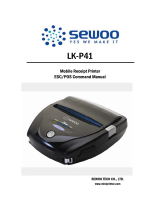
Federal Communications Commission (FCC) Radio Frequency Interference Statement Warning
Changes or modications to this unit not expressly approved by the party responsible for compliance could void the user’s authority
to operate the equipment.
Note
This equipment has been tested and found to comply with the limits for a Class A digital device, pursuant to Part 15 of the FCC
Rules. These limits are designed to provide reasonable protection against harmful interference when the equipment is operated in
a commercial environment. This equipment generates, uses, and can radiate radio frequency energy and, if not installed and used in
accordance with the instruction manual, may cause harmful interference to radio communications. Operation of this equipment in
a residential area is likely to cause harmful interference in which case the user will be required to correct the interference at his own
expense.
Information to the User
This equipment must be installed and used in strict accordance with the manufacturer’s instructions. However, there is no guarantee
that interference to radio communications will not occur in a particular commercial installation. If this equipment does cause
interference, which can be determined by turning the equipment o and on, the user is encouraged to contact CognitiveTPG
immediately.
CognitiveTPG is not responsible for any radio or television interference caused by unauthorized modication of this equipment or
the substitution or attachment of connecting cables and equipment other than those specied by CognitiveTPG. The correction of
interferences caused by such unauthorized modication, substitution or attachment will be the responsibility of the user.
In order to ensure compliance with the Product Safety, FCC and CE marking requirements, you must use the power supply, power
cord, and interface cable which are sold for use with this product or which meet the following parameters:
Power Supply
UL Listed (QQGQ), Class 2 power supply with SELV (Secondary Extra Low Voltage), non-energy hazard output, limited energy source,
input rated 100-240 Vac, 1.5/0.8 A, 50/60 Hz, output rated 24 Vdc, 2.3 A for 55 watt unit; 100-240 Vac, 2.0A, 50/60 Hz, output rate 24
Vdc, 3.125 A for 75 watt unit.
Use of this product with a power supply other than the CognitiveTPG power supply will require you to test the power supply and
CognitiveTPG printer for FCC and CE mark certication.
Communication Interface Cable
A shielded (360 degree) interface cable must be used with this product. The shield must be connected to the frame or earth ground
connection or earth ground reference at EACH end of the cable.
Use of a cable other than described here will require that you test the cable with the CognitiveTPG printer and your system for FCC
and CE mark certication.
Power Cord
A UL listed, detachable power cord must be used. For applications where the power supply module may be mounted on the oor, a
power cord with Type SJT marking must be used. For applications outside the US, power cords which meet the particular country’s
certication and application requirements should be used.
Use of a power cord other than described here may result in a violation of safety certications which are in force in the country of
use.
Industry Canada (IC) Radio Frequency Interference Statement
This Class A digital apparatus meets all requirements of the Canadian Interference-Causing Equipment Regulations.
Cet appareil numérique de la classe A respecte toutes les exigences du Règlement sur le matériel brouilleur du Canada.
Voluntary Control Council for Interference (VCCI) Radio Frequency Interference Statement
This is a Class A product based on the standard of the Voluntary
Control
Council for Interference by Information Technology Equipment
(VCCI). If this equipment is used in a domestic environment, radio
disturbance may arise. When such trouble occurs, the user may be
required to take corrective actions.
Disclaimer
Information in this document is subject to change without notice. Consult your CognitiveTPG sales representative for information
that is applicable and current. CognitiveTPG reserves the right to improve products as new technology, components, software, and
rmware become available.
No part of this document may be reproduced, transmitted, or translated in any form or by any means, electronic or mechanical, for
any purpose without the express written permission of CognitiveTPG.
Copyright
Copyright © 2009 by TPG IPB, Inc., 950 Danby Road, Ithaca, New York 14850, USA. All rights reserved. Printed in USA. Condential,
Unpublished. Property of TPG IPB, Inc.
Trademarks
CogntiveTPG™ is a trademark of TPG IPB, Inc.
Microsoft, Windows NT are registered Trademarks of Microsoft Corporation in the U.S.A. and/or other countries.
Inside Out Networks, Inside Out, EPIC, and Edgeport are trademarks of Inside Out Networks.
All other trademarks and registered trademarks are the property of their respective holders.
Patents
Made under one or more of the following U.S. patents: 4886381, 5579043, 5613787, 5651624, 5713678, 5752779, 5789916,
5800080, 5879090, 5887999, 5975776, 6027266, 6085973, 6089450, 6129465, 6155483, 6404452, 6486902, 6504331, 5749277,
6722754, 6739773, 6784909.
Web Site
http://www.CognitiveTPG.com






















